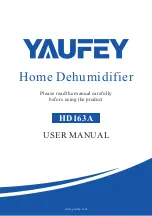
quest
Asset Protection and IAQ Solutions
quest
1-800-533-7533
10
www.QuestProtect.com
HI-E DRY 100
Installation, Operation and Maintenance Instructions
quest
quest
5.6 Compressor/Capacitor Replacement
This compressor is equipped with a two terminal external overload, run capacitor, but no start capacitor or
relay (see Fig. 4).
CAUTION-ELECTRICAL SHOCK HAZARD: Electrical power must be present to perform some tests; these
tests should be performed by a qualified service person.
5.6A Checking Compressor Motor Circuits
Perform the following tests if the blower runs but the compressor does not with the humidity control ON.
1. Turn the humidity control OFF and unplug the unit, remove the cabinet front (6 screws).
2. Plug in the unit and turn the humidity control ON. Use a voltmeter to check for 110 to 120 volts between
(a) the relay terminal that the black wire from the compressor connects to and (b) the capacitor terminal
with the (2) white wires, (1) red wire & (1) brown wire connected. If voltage is present, go to step 3. If
no voltage, the defrost thermostat, the relay or the condensate pump safety switch are open or there is
a loose connection in the compressor circuit. Test each component for continuity; see the appropriate
section if a defect is suspected.
3. Turn the humidity control OFF and unplug the unit, then disconnect the red and yellow wires from
compressor terminals R & S. Using an ohmmeter check continuity between the points listed below.
4. Compressor terminals C and S: No continuity indicates an open start winding; the compressor must be
replaced.
5. Compressor terminals C and R: No continuity indicates an open run winding; the compressor must be
replaced.
6. Compressor terminal C and overload terminal 1: No continuity indicates a defective overload lead.
7. Overload terminals 1 and 3: If there is no continuity, the overload may be tripped; wait 10 minutes and
try again. If there is still no continuity, it is defective and must be replaced.
8. Compressor terminal C and compressor case: Continuity indicates a grounded motor; the compressor
must be replaced.
9. Disconnect the wires from the capacitor. Set the ohmmeter to the Rx1 scale; the capacitor is shorted and
must be replaced if continuity exists across its terminals. If there is no needle movement with the meter
set on the Rx100000 scale, the capacitor is open and must be replaced.
10. Reconnect the wires to the compressor and capacitor; plug in and turn on the unit. If the compressor
fails to start, replace the run capacitor.
11. If the unit still does not start, adding a hard-start kit will provide greater starting torque. If this does not
work, the compressor has an internal mechanical defect and must be replaced.
5.6B Replacing a Burned Out Compressor
The refrigerant and oil mixture in a compressor is chemically very stable under normal operating conditions.
However, when an electrical short occurs in the compressor motor, the resulting high temperature arc causes
a portion of the refrigerant oil mixture to break down into carbonaceous sludge, a very corrosive acid, and
water. These contaminants must be carefully removed otherwise even small residues will attack replacement
compressor motors and cause failures.


































